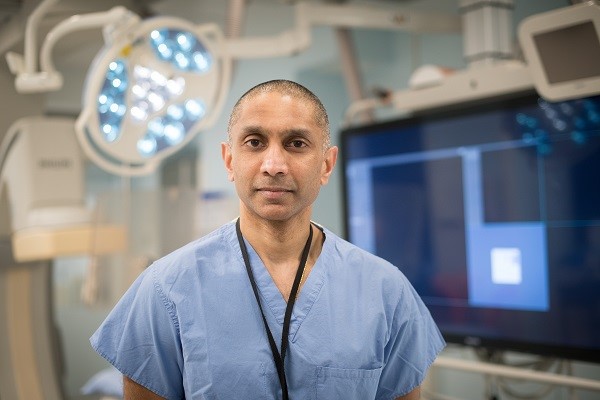
Stories
Increasing cost-effectiveness for TAVI – the standard of care for aortic stenosis
Transcatheter Aortic Valve Implantation (TAVI) is becoming an increasingly common and cost-effective alternative to open-heart surgery that benefits patients and decreases...

Dr. Wijeysundera. Photo credit: Kevin Van Paassen / Sunnybrook Health Sciences Centre.
By Carmela Reyes
Transcatheter Aortic Valve Implantation (TAVI) is becoming an increasingly common and cost-effective alternative to open-heart surgery that benefits patients and decreases hospital stays.
A minimally invasive, catheter-based procedure, TAVI addresses the narrowing of the aortic valve (aortic stenosis, AS) by replacing the function of the valve with a bio-prosthetic valve implanted into the patient’s heart via a catheter inserted in their groin.
While TAVI was initially reserved primarily for extreme high-risk patients, its use has been expanded to patients in lower-risk categories in some provinces, with funding varying by province.
About 30 hospitals across Canada currently perform TAVI procedures but many of their program directors have been grappling with how to improve access to this minimally invasive surgery when the funding favours standard surgical aortic valve replacement (SAVR).
Dr. Harindra Wijeysundera and his colleagues have figured it out.
Dr. Wijeysundera is chief of the Schulich Heart Program at Sunnybrook Health Sciences Centre and an interventional cardiologist at Sunnybrook, which performs 300-325 TAVIs per year.
“TAVI is no longer an innovative procedure, it’s the standard of care for certain patients who have AS,” he said. “So really, it becomes incumbent on us as providers in the system to be able to provide that standard of care.”
Two key factors have made it challenging to provide TAVI to all eligible candidates. First, the per-patient funding approach for TAVI doesn’t allow treatment for as many patients as are referred. Second, the prosthesis can be more expensive up front than what is used for SAVR.
TAVI is no longer an innovative procedure, it’s the standard of care for certain patients who have AS.
But Dr. Wijeysundera believes these issues related to TAVI costs can be mitigated by early discharge and fewer complications, both of which save on hospital resources.
“The value proposition for TAVI is not the prosthesis itself,” he said. “Instead, it is the ability to rapidly mobilize patients and allow them to get home earlier. Because of this, the hospital stay for the TAVI procedure is cheaper than SAVR,” he said, adding that 99 per cent of the procedures are using femoral access (through a small incision in the thigh), with local anesthetic and sedation.
At Sunnybrook, the median length of stay for SAVR is five to seven days, whereas for TAVI it is one day. “To lower the cost of delivering care in the hospital, we were very aggressive in adopting pathways to help discharge patients sooner.”
For the past several years, Dr. Wijeysundera has been working to demonstrate that there is a clear need for greater funding for TAVI procedures, and is a member of an advisory group that offers recommendations to the health ministry on how best to allocate funding and improve patient access to life-saving medical treatments.
“TAVI has become a safe, minimally invasive option preferred by patients, and is now affordable for the health-care system,” says Dr. Wijeysundera. “Despite this, there is still substantial inequity in access across Canada that should be addressed so patients can get the care they need.”
Carmela Reyes is a Sr. Communications Lead at Medtronic.


